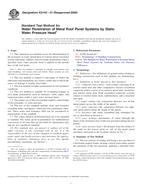Wir benötigen Ihre Einwilligung zur Verwendung der einzelnen Daten, damit Sie unter anderem Informationen zu Ihren Interessen einsehen können. Klicken Sie auf "OK", um Ihre Zustimmung zu erteilen.
ASTM E2140-01(2009)
Standard Test Method for Water Penetration of Metal Roof Panel Systems by Static Water Pressure Head
Automatische name übersetzung:
Standard Test Method for Wasserpenetration in Metall Dach-Panel Systems durch statische Wasserdruck Leiter
NORM herausgegeben am 1.11.2009
Informationen über die Norm:
Bezeichnung normen: ASTM E2140-01(2009)
Anmerkung: UNGÜLTIG
Ausgabedatum normen: 1.11.2009
SKU: NS-44446
Zahl der Seiten: 4
Gewicht ca.: 12 g (0.03 Pfund)
Land: Amerikanische technische Norm
Kategorie: Technische Normen ASTM
Kategorie - ähnliche Normen:
Die Annotation des Normtextes ASTM E2140-01(2009) :
Keywords:
endlap, metal panel, roof, roof panel, sideseam, static water pressure, water, water leakage, water penetration, Metal roof panel systems, Static tests--building materials/applications, Water penetration--roofing materials/applications, ICS Number Code 91.060.20 (Roofs)
Ergänzende Informationen
| Significance and Use | ||||
|
This test method is a standard procedure for determining water leakage through metal roof panel system sideseams, endlaps, and roof plane penetrations when the roof system is subjected to a specified static water pressure head. Note 2—In applying the results of tests by this method, note that the performance of a roof or its components or both, is in part a function of proper installation and adjustment. In service, the performance will also depend on the integrity of the supporting construction, roof slope, and on the resistance of components to deterioration by various causes: corrosive atmosphere, aging, ice, vibration, thermal cycling, etc. It is difficult to simulate the identical complex wetting, aging, and other variable conditions that can be encountered in service, including wind-blown ponded water; the effects of temperature and age on sealant performance; differential pressure across the joints due to wind, snow, and ice accumulation; densification and migration; and abrasions within the joint components which may occur during thermal cycling and other weather events. Some joint conditions are more sensitive than others to these factors. This test method will evaluate the resistance of roof panels, sideseams, endlaps, and roof plane penetrations to water submersion. It will not evaluate panel resistance to wind driven rain. Note 3—See Test Method E1646 for a test which evaluates resistance to wind driven rain. This test method is not a structural adequacy test. This test method is applicable to single skin metal panels, the exterior skin of factory assembled composite panels, and the exterior skin of field assembled composite systems as long as means can be provided to distinguish leakage through the exterior panel sideseams/endlaps and perimeter leakage. |
||||
| 1. Scope | ||||
|
1.1 This laboratory test method covers the determination of the resistance to water penetration of exterior metal roof panel system sideseams, endlaps, and roof plane penetrations when a specified static water pressure head is applied to the outside face of the roof panel. Note 1—This test method is intended to evaluate water-barrier (not water-shedding) roof system joints and details. These systems are also referred to as hydrostatic roof systems. 1.2 This test method is limited to specimens in which the sideseams and attachments are clearly visible and in which the source of leakage is readily observable. 1.3 This test method excludes performance at roof perimeter conditions. 1.4 This test method is suitable for evaluating leakage at roof plane penetrations such as fasteners, curbs, pipes, and expansion joints under a static water pressure head. 1.5 The proper use of this test method requires a knowledge of the principles of water pressure. 1.6 The text of this standard includes notes and footnotes excluding tables and figures, which provide explanatory material. These notes and footnotes shall not be considered as requirements of the standard. 1.7 The values stated in inch-pound units are to be regarded as standard. The values given in parentheses are mathematical conversions to SI units that are provided for information only and are not considered standard. 1.8 This standard does not purport to address all of the safety concerns, if any, associated with its use. It is the responsibility of the user of this standard to establish appropriate safety and health practices and determine the applicability of regulatory limitations prior to use. For specific precautionary statements, see Section 7. |
||||
| 2. Referenced Documents | ||||
|
Ähnliche Normen:
Historisch
15.10.2012
Historisch
1.1.2012
Historisch
15.1.2010
Historisch
1.10.2013
Historisch
15.8.2011
Historisch
1.4.2012
Empfehlungen:
Aktualisierung der technischen Normen
Wollen Sie sich sicher sein, dass Sie nur die gültigen technischen Normen verwenden?
Wir bieten Ihnen eine Lösung, die Ihnen eine Monatsübersicht über die Aktualität der von Ihnen angewandten Normen sicher stellt.
Brauchen Sie mehr Informationen? Sehen Sie sich diese Seite an.



 ASTM D7186-12
ASTM D7186-12 ASTM D7655/D7655M-12..
ASTM D7655/D7655M-12.. ASTM E108-11
ASTM E108-11 ASTM E1091-13
ASTM E1091-13 ASTM E1514-98(2011)..
ASTM E1514-98(2011).. ASTM E1592-05(2012)..
ASTM E1592-05(2012)..
 Cookies
Cookies
